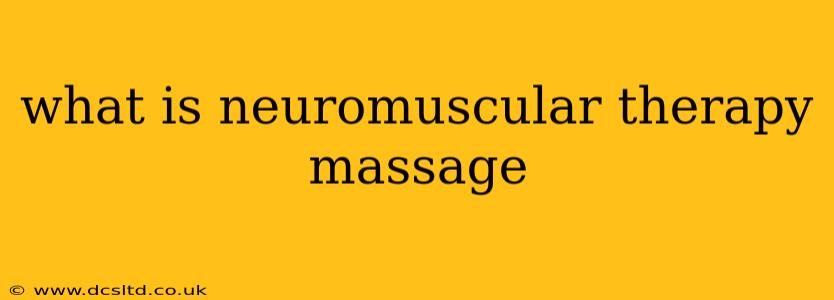Neuromuscular therapy (NMT) massage is a specialized, advanced form of massage therapy that focuses on addressing musculoskeletal pain and dysfunction by targeting specific points in the body called trigger points. These trigger points are hyperirritable spots in skeletal muscle that, when compressed, can cause localized pain and refer pain to other areas of the body. Unlike a typical relaxation massage, NMT aims to release these trigger points and restore proper muscle function. It's a precise and often intense technique that requires skilled practitioners.
How Does Neuromuscular Therapy Work?
NMT therapists use a variety of techniques to locate and treat trigger points. These techniques may include:
- Digital pressure: Applying direct pressure to the trigger point with fingers to release tension. This is often a sustained pressure, held for several seconds.
- Stretching: Gently stretching the affected muscle to improve flexibility and lengthen shortened muscle fibers.
- Passive joint mobilization: Moving the joint through its range of motion to improve mobility and address joint restrictions.
- Post-isometric relaxation: A technique that involves isometric contraction (muscle contraction without movement) followed by passive stretching. This helps to relax the muscle and reduce muscle spasm.
- Muscle energy techniques: Utilizing the patient's active muscle contractions to help release restrictions in the affected muscle.
The goal is to release the tension in the muscle, improve circulation, reduce pain, and restore proper muscle function. The therapist carefully assesses the patient’s posture, range of motion, and muscle palpation to identify trigger points and develop a personalized treatment plan.
What are the Benefits of Neuromuscular Therapy?
NMT massage offers a range of potential benefits, including:
- Pain relief: By addressing trigger points, NMT can effectively reduce pain associated with muscle tension, strains, and spasms.
- Improved range of motion: Releasing muscle tension improves flexibility and allows for a greater range of motion.
- Reduced muscle spasms: NMT can help to relax and lengthen muscles that are in spasm, reducing pain and improving function.
- Improved posture: By addressing muscle imbalances, NMT can help to correct postural distortions and improve overall body alignment.
- Increased athletic performance: For athletes, NMT can help to prevent injuries, reduce recovery time, and enhance performance.
- Stress reduction: While not its primary focus, the process can promote relaxation and stress reduction.
What Conditions Might Benefit from Neuromuscular Therapy?
NMT can be beneficial for a wide range of conditions, including:
- Muscle strains and sprains: It helps to reduce pain and inflammation and accelerate healing.
- Back pain: Addresses muscle tension and trigger points that contribute to back pain.
- Neck pain: Relieves tension in neck muscles and improves range of motion.
- Headaches (including tension headaches and migraines): Treats muscle tension in the neck and shoulders, often associated with headaches.
- Sciatica: Addresses muscle imbalances that contribute to sciatic nerve pain.
- Fibromyalgia: Helps to reduce pain and improve function in individuals with fibromyalgia.
- Temporomandibular joint (TMJ) disorders: Addresses muscle tension in the jaw and surrounding areas.
Is Neuromuscular Therapy Painful?
While the process of locating and treating trigger points can sometimes be uncomfortable, it shouldn't be excruciatingly painful. A skilled NMT therapist will work within your pain tolerance and adjust the pressure as needed. It is important to communicate openly with your therapist about your comfort level. Discomfort is usually temporary and followed by significant pain relief.
How Many Neuromuscular Therapy Sessions Will I Need?
The number of sessions needed varies greatly depending on the individual's condition, the severity of the problem, and their response to treatment. Some individuals may experience significant relief after just one or two sessions, while others may require a series of treatments. Your therapist will be able to provide you with a more accurate estimate after an initial assessment.
What to Expect During a Neuromuscular Therapy Session?
During your first session, your therapist will conduct a thorough assessment to evaluate your posture, range of motion, and palpate your muscles to identify trigger points. They will explain the treatment plan and answer any questions you have. Subsequent sessions will involve the application of various NMT techniques to treat the identified trigger points. You may experience some soreness after a session, but this is usually temporary.
What is the difference between Neuromuscular Therapy and Deep Tissue Massage?
While both NMT and deep tissue massage target deeper muscle layers, they differ in their focus and techniques. Deep tissue massage aims to generally relieve muscle tension and improve circulation. NMT is more specific, targeting trigger points with precise pressure and other techniques to address the underlying cause of muscle pain and dysfunction. NMT is considered a more specialized and advanced technique.
Remember, this information is for general knowledge and does not constitute medical advice. Always consult with a qualified healthcare professional or licensed massage therapist before starting any new treatment. A proper diagnosis is crucial before undertaking any therapy.
